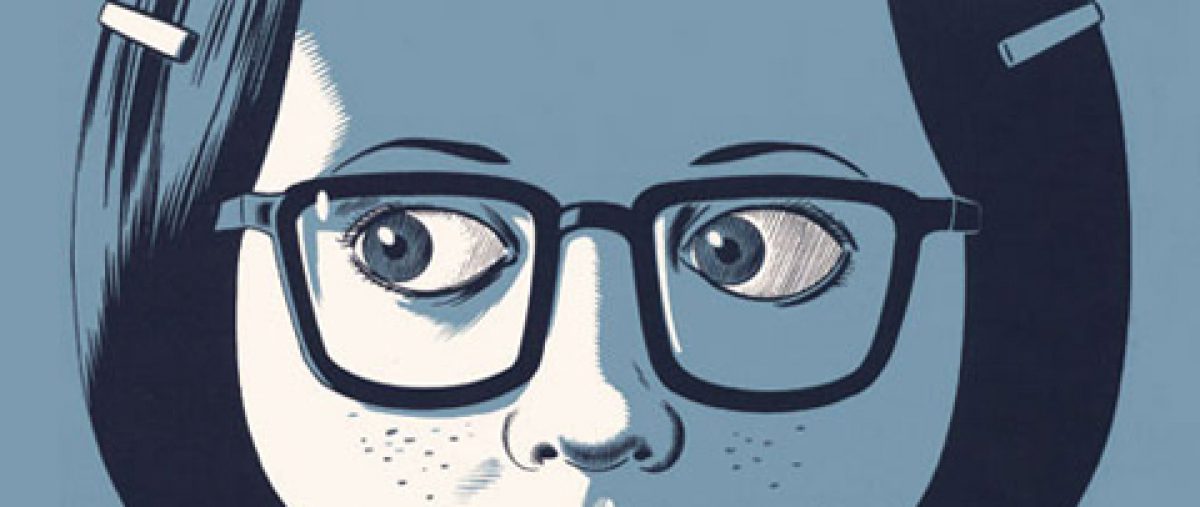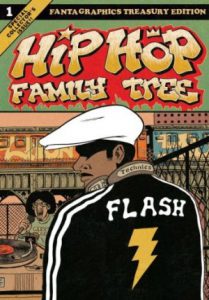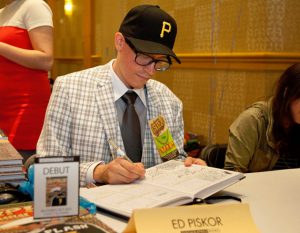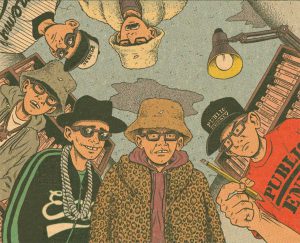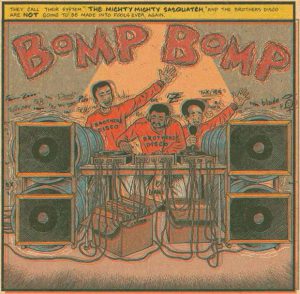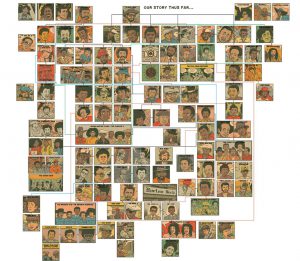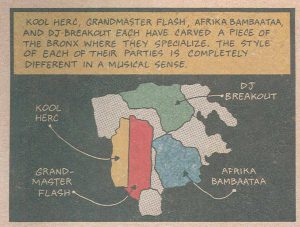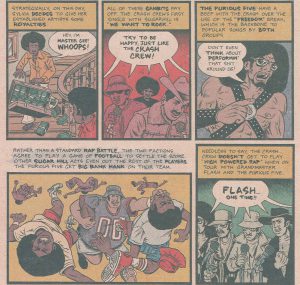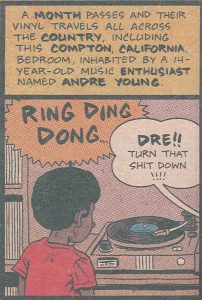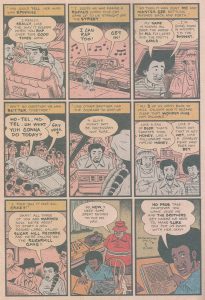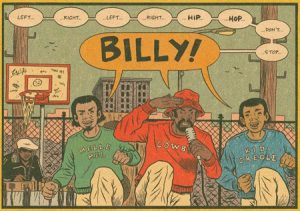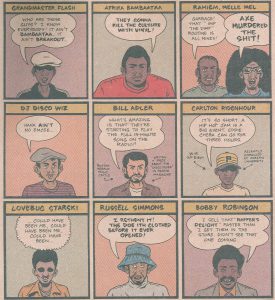Originally published on GoshenCommons.org April 21, 2014
(Update: “Hip Hop Family Tree” is up to Volume 4, which was released in August 2016. Check it out at Better World Books online.)
“Hip Hop Family Tree,” the first collected volume from the weekly comic still running on Boing Boing, was backordered almost immediately after its release in December 2013, and is already on its third printing. Apparently I’m not the only one itching for the diversification of comics to pick up speed.
Creator Ed Piskor may be a “little white dude,” as he refers to himself,
Images from comicsalliance.com and boingboing.net.
but he’s more than qualified to take on this topic—in fact, he’s obsessed with the genre. As he explains in an interview in “The Comics Journal,” he regularly gets interrogated by fans at comics conventions, but he has no trouble standing his ground. “I invite challenge because I really do feel like my trivial knowledge is a little bit ridiculous when it comes to this stuff.” (Read the whole interview at http://www.tcj.com/the-ed-piskor-interview/.)
Whether you’re a fan of the music or not, this is a brilliant and beautiful book: Piskor’s enthusiasm emanates from every page, and since the strip is still running on Boing Boing (http://boingboing.net/tag/hip-hop-family-tree), he’s made sure that it’s worthwhile to own the hard copy. As comics nerd Rob Clough notes on his blog High Low Comics, “Piskor, a design fiend, is using the exact proportions and cover design of the old Marvel Treasury Editions. The lettering, coloring (love those pre-yellowed pages!), character design and overall dynamics of the book are meant to emulate Marvel comics from the late 70s and early 80s.”
While I’m not near enough of a comics nerd to place the exact era and publisher, what I did notice when I first opened this book was the smell: the paper and ink brought me right back to those comics I used to scam from my older brother or buy from the spinning wire racks at the drug store. Much like hip hop itself, Piskor is riffing off of and reinterpreting the old school. He even represents the printing mistakes of old-school comics, but only when there’s a bass line booming, jarring the colors out of their proper places:
Image from mentalfloss.com.
If you don’t know much about the genre, your brain might start to feel a bit rattled, too, as you read. The original serial nature of the story can be disorienting, jumping from topic to topic with no segues or title pages, and the monstrous cast of characters is especially confusing as real names morph into stage names, then stage names change to stay current. Piskor himself uses a wall map to keep track—he says he was inspired by the television series “The Wire.” The map continues to grow, but here’s its most recent incarnation:
Image from boingboing.net.
And here’s a visual explanation of how the earliest rappers and DJs mapped onto the New York City boroughs:
Don’t be discouraged by the name dropping: this is a crucial story of the development of music history in the U.S., but there’s no test at the end. Even if you don’t catch every name, and don’t hear the music behind the lyrics Piskor pens into the frames, the stories are powerful and inspiring. Not only is this a genre unique to the U.S., but it’s a genre built by talent, community and dedication.
To be true to the story, Piskor shows some of the violence and bling that many associate with hip hop, but he also shows an equal number of frames that subvert those destructive stereotypes. My favorite is a game of football to resolve a dispute between two crews, The Crash Crew and the Furious Five, who sampled the same break in their live shows:
Also endearing are the young versions of famous rappers, some so young they have to hold shows early so they can get home in time for curfews. Here’s a young Dr. Dre, for example:
And here’s Sylvia Robinson of Sugarhill Records, now a media mogul, who ran her first auditions in the backseat of a car:
I especially hope that Piskor’s version of hip hop history succeeds because it’s so inspiring: this is a genre built from the ground up, by creative people and creative communities trying to find productive ways to channel their energy in often stifling, and way too often dangerous, surroundings. Here’s Piskor’s now viral image of what many claim is the first use of the term, at a party to send a teen named Billy off to the military:
Image from boingboing.net.
Of course there’s more than one version of the story, and Piskor does his best to represent competing narratives in pages like this one, which chronicles the range of reactions to the 1979 release of “Rapper’s Delight” by the Sugarhill Gang, arguably the genre’s first mainstream single:
“You’ve got to understand what the climate was like in New York back in the ‘70s,” says Piskor in his “Comics Journal” interview, when asked about his lifelong fascination with hip hop. “[A]ll this funding was being cut from schools and there were no music departments, yet music was such a part of everybody’s lives. So what did they do? They just got together whatever they could, whatever could make some noise, and they figured out how to use that to be creative in their own ways. It’s remarkable.” Whatever new cultural zeitgeist is waiting in the wings, it’s DIY storytelling like Piskor’s that will help make it happen.
Find your literary inspiration at Better World Books in Goshen, Indiana.
See you in two weeks for epic storytelling of a different sort: Isabel Greenberg’s “Encyclopedia of Early Earth.”
